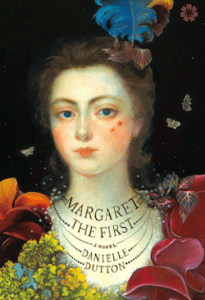
Margaret Cavendish—neè Lucas, erstwhile Maid of Honor to Queen Henrietta Maria, and ultimately the Duchess of Newcastle-Upon-Tyne—was named “Mad Madge” by the Restoration-era English public; disparaged as a “benchmark of absurdity” and dismissed with condescension (“there are many soberer people in bedlam”) by some of her contemporaries; and memorialized by Virginia Woolf as a “giant cucumber [that] spread itself over all the roses and carnations in the garden and chocked them to death” in A Room of One’s Own. Margaret Cavendish is also the fascinating subject of Danielle Dutton’s hypnotic new novel, Margaret the First. A noblewoman, philosopher, and published writer, Cavendish and her notorious celebrity were well suited to the peculiar events of 17th-century Britain, which included the first regicide in Europe, an Interregnum marked by puritanical ambition, and the excesses and colonial expansion of the Restoration. The famed London diarist Samuel Pepys wrote of Cavendish, “The whole story of this lady is a romance, and everything she does.” Dutton’s novel hews true to his words, and beautifully so.
Dutton divides Margaret the First into three primary parts, the first of which, “A True Relation of My Birth and Breeding,” is told in Cavendish’s voice—perhaps an allusion to the short autobiography, by a similar title, that Cavendish wrote in one of her books—while the following two are told in the third person. These disparate narrative voices are united by Dutton’s stunningly evocative writing, which includes some of the most striking sentences I’ve read in some time: a gown is “bruised like an autumn fruit,” and a forest in Nottinghamshire springs from the page with “mushrooms on rotted bark, cinnamon ferns in mud.” “Dust hangs in a crack of light between red velvet drapes, like stars,” and “in hiding at a royalist estate in Exeter—the sea, the air, the double white violet, the wallflower, stock-gilliflower, cowslip, flower-de-lices, cherry trees in pink—the queen gave birth to a princess, soft and yellow, streaked with blood, the labor causing hysterical blindness and a lingering pain in Her Majesty’s chest.” With just a few precise brushstrokes, Dutton paints a gorgeous, richly detailed world that lingers long after the novel ends; this sublime writing and imagery are the book’s great strengths.

At the narrative heart of the novel lies the tangle of Cavendish’s various identities—woman, daughter, sister, wife, and stepmother on the one hand, philosopher and writer on the other—and the conflict these identities generate for Cavendish and the people in her life. Early on, for example, Cavendish’s first menstruation merits its own chapter; Cavendish’s mother insists it is now time for her to move to a new bedroom, and she hears rumors from the servants in her family home about what it means that she is now a “bleeding girl.” This chapter suggests the beginning of a predictable progression in Cavendish’s life as a woman—it alludes to a future symmetry, perhaps a later chapter or section on the birth of a child. But Cavendish and her husband (William Cavendish, the Duke of Newcastle-upon-Tyne) prove unable to conceive, and as the novel progresses, this childlessness is a thread that weaves through her artistic ambitions, her husband’s love for her and frustration with her, the occasional disdain of her extended family, and the mingling rage, sadness, and disquiet she feels when she considers her situation as a woman “without even any children to dignify her life.” It may be a step too far to argue that this very novel, not to mention Cavendish’s own texts, are wonderful rebukes to that sentiment, but the art she created and still inspires certainly dignify her memory.
What sort of a woman is Margaret Cavendish? Within these pages, Cavendish seems to exist outside of the male-female binary to which the other characters conform. She aggressively pursues her own ambitions, and not only publishes her work in her own name, but also sends it to the Court, the heads of Oxbridge colleges, and a number of distinguished thinkers and philosophers. A shy woman, she is at first assumed to bear no thoughts or opinions at the public engagements she attends with her husband; her forceful writing ultimately refutes this impression, and she argues not merely that women can think, but also that “there is no creature or part of nature without innate sense and reason,” an argument that still distinguishes her philosophy today. Because Parliament considers women to be minors, regardless of their age or station, and because “there could be no use in having children swear a loyalty oath,” Cavendish can travel freely into Interregnum England—and so it is that while considered a child in the eyes of the law she strikes a deal with a publisher for her first book. Decades later, with her celebrity already reaching celestial proportions, she appears in a mask and a topless dress at the performance of a play that her husband proudly and secretly wrote… and which everyone afterwards assumes was written by her. As the years pass, Cavendish becomes “reconciled to childlessness, [and] worries instead about barrenness of the brain.”
This is not a novel to read for a clear and chronological accounting of the various works Cavendish wrote, nor is it historical fiction that aspires to straightforward biography. It is instead an elegant and expansive work of art—one that is as much a tribute to the life of the mind writ large as it is to the spirit of the remarkable Duchess of Newcastle-upon-Tyne, that giant cucumber and benchmark of absurdity, the one and only Margaret Cavendish.




